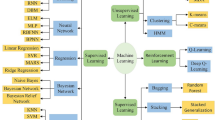Abstract
A prediction model for methane production in a wastewater processing facility is presented. The model is built by data-mining algorithms based on industrial data collected on a daily basis. Because of many parameters available in this research, a subset of parameters is selected using importance analysis. Prediction results of methane production are presented in this paper. The model performance by different algorithms is measured with five metrics. Based on these metrics, a model built by the Adaptive Neuro-Fuzzy Inference System algorithm has provided most accurate predictions of methane production.








Similar content being viewed by others
References
Ahn, H., & Kim, K. (2008). Using genetic algorithms to optimize nearest neighbors for data mining. Annals of Operations Research, 163(1), 5–18.
Cakmakci, M. (2007). Adaptive neuro-fuzzy modeling of anaerobic digestion of primary sedimentation sludge. Bioprocess and Biosystems Engineering, 30(5), 349–357.
Dochain, D. (1995). Recent approaches for the modeling, monitoring and control of anaerobic digestion processes. In Proceedings of the international workshop on monitoring and control of anaerobic digestion processes (pp. 23–29).
Hamoda, M., Al-Ghusain, I., & Hassan, A. (1999). Integrated wastewater treatment plant performance evaluation using artificial neural networks. Water Science and Technology, 40(7), 55–65.
Holubar, P., Zani, L., Hagar, M., Froschl, W., Radak, Z., & Braun, R. (2000). Modeling of anaerobic digestion using self-organizing maps and artificial neural nets. Water Science and Technology, 41(12), 149–156.
Holubar, P., Zani, L., Hagar, M., Froschl, W., Radak, Z., & Braun, R. (2002). Advanced controlling of anaerobic digestion by means of hierarchical neural networks. Water Research, 36(10), 2582–2588.
Jang, J. (1993). ANFIS: Adaptive-network-based fuzzy inference systems. IEEE Transactions on Systems, Man, and Cybernetics, 23(3), 665–685.
Jiao, T., Peng, J., & Terlaky, T. (2009). A confidence voting process for ranking problems based on support vector machines. Annals of Operations Research, 166(1), 23–38.
Kusiak, A., & Salustri, F. A. (2007). Computational intelligence in product design engineering: review and trends. IEEE Transactions on Systems, Man and Cybernetics. Part C, 37(5), 766–778.
Kusiak, A., & Smith, M. (2007). Data mining in design of products and production systems. Annual Reviews in Control, 31(1), 147–156.
Kusiak, A., Caldarone, C., Kelleher, M., Lamb, F., Persoon, T., & Burns, A. (2006). Hypoplastic left heart syndrome: knowledge discovery with a data mining approach. Computers in Biology and Medicine, 36(1), 21–40.
Kusiak, A., Zheng, H. Y., & Song, Z. (2009). Wind farm power prediction: a data-mining approach. Wind Energy, 12(3), 275–293.
Kusiak, A., Li, M. Y., & Tang, F. (2010a). Modeling and optimization of HVAC energy consumption. Applied Energy, 87(10), 3092–3102.
Kusiak, A., Li, M. Y., & Zheng, H. Y. (2010b). Virtual models of indoor-air-quality sensors. Applied Energy, 87(6), 2087–2094.
Marchaim, U. (1992). Biogas process for sustainable development. Rome: Food and Agriculture Organization of the United Nations.
Muller, W., & Wysotzki, F. (1994). Automatic construction of decision trees for classification. Annals of Operations Research, 52(4), 231–247.
Pontes, F., & Pinto, J. (2006). Analysis of integrated kinetics and flow models for anaerobic digesters. Journal of Chemical Engineering, 122(1–2), 65–80.
Schubert, J., Simutis, R., Dors, M., Havlik, I., & Lubbert, A. (1994). Bioprocess optimization and control: application of hybrid modeling. Journal of Biotechnology, 35(1), 51–68.
Shah, S., Kusiak, A., & O’Donnell, M. (2006). Patient-recognition data-mining model for BCG-plus interferon immunotherapy bladder cancer treatment. Computers in Biology and Medicine, 36(6), 634–655.
Steyer, J., Amouroux, M., & Moletta, R. (1995). Process modeling and control to improve stable operation and optimization of anaerobic digestion process. In Proceedings of the international workshop on monitoring and control of anaerobic digestion processes (pp. 30–35).
Takada, T., Sanou, K., & Fukumara, S. (1995). A neural network system for solving an assortment problem in the steel industry. Annals of Operations Research, 57(1), 265–281.
Tan, P. N., Steinbach, M., & Kumar, V. (2006). Introduction to data mining. Boston: Pearson Education.
Tay, J., & Zhang, X. (1999). Neural fuzzy modeling of anaerobic biological wastewater treatment systems. Journal of Environmental Engineering, 125(12), 1149–1159.
Venkateswarlu, C., & Naidu, K. (2000). Dynamic fuzzy model based predictive controller for a biochemical reactor. Bioprocess and Biosystems Engineering, 23(2), 113–120.
Wang, Q., Sun, X., Golden, B. L., & Jia, J. (1995). Using artificial neural networks to solve the orienteering problem. Annals of Operations Research, 61(1), 111–120.
Witten, I. H., & Frank, E. (2005). Data mining: practical machine learning tools and techniques. San Francisco: Morgan Kaufmann.
Yin, X., Han, P., & Lu, X. (2004). A review on the dewaterability of bio-sludge and ultrasound pretreatment. Ultrasonics Sonochemistry, 11(6), 337–348.
Zheng, H. Y., & Kusiak, A. (2009). Prediction of wind farm power ramp rates: a data-mining approach. Journal of Solar Energy Engineering, 131(3), 031011-1-8.
Acknowledgements
This research was supported by funding from the Iowa Energy Center Grant No. 10-1.
Author information
Authors and Affiliations
Corresponding author
Rights and permissions
About this article
Cite this article
Kusiak, A., Wei, X. Prediction of methane production in wastewater treatment facility: a data-mining approach. Ann Oper Res 216, 71–81 (2014). https://doi.org/10.1007/s10479-011-1037-6
Published:
Issue Date:
DOI: https://doi.org/10.1007/s10479-011-1037-6




